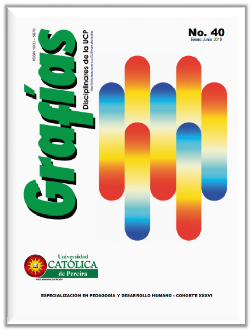The teacher's teaching approach to the learning style in a group of nursing practice students from the INEC Institute of Pereira
DOI:
https://doi.org/10.31908/grafias.v0i40.2641Keywords:
learning, learning styles, learning and educationAbstract
The objective of the research was to identify the learning styles in healthcare practice students from the INEC Institute of Pereira, with a sample of fourteen students with an average lower than 3.9. It was a mixed phenomenological investigation developed in two phases: a survey was applied to characterize the students, it was observed that the reflective style predominated in 64.3% and a focus group was held to know the opinion of the students about the implemented methodology . The type of learning makes teachers train and use appropriate strategies with the styles of each student.
References
Ascue, S. (2007). El sentido y la apuesta por la educación inclusiva. Revista Educación, 16 (30), p. 79-82.
Cea, M. (2001). Metodología cuantitativa: Estrategias y técnicas de investigación social. (3. ª Reimpresión). Editorial Síntesis Sociología.
Hernández, R., Fernández, C., y Baptista, P. (2003). Metodología de la investigación.(3. ª ed.). McGraw-Hill.
Kolb, D. (2014). Ciclo de aprendizaje experiencial de Kolb. Intercultural Link an AFS Learning Program, p. 1-3.
LeCompte, M., y Schensul, J. (1999). Designing and Conducting Ethographic Research. [Diseño y realización de investigación etnográfica].AltaMira Press.
Maureira, F. (2016). Estilos de aprendizaje de Kolb de estudiantes de educación física de la UMCE y UISEK de chile. Revista Estilos de Aprendizaje, 11 (6), p. 139-150.
Maureira, F., y Flores, E. (2016). Estilos de aprendizaje en estudiantes de educación: una revisión del 2000 al 2015. Revista electrónica de Psicología Iztacala, 9 (1), p. 74-91.
Mejía, M. (2017). La Innovación: asunto central de la sociedad del siglo XXI. Una búsqueda educativa por modernizartransformar la escuela. Revista Educación y Ciudad, 11-13 (32), p. 23-41.
Mera, M., y Amores, P. (2017). Estilos de aprendizaje y sistemas de representación mental de la información. Revista Publicando, 4 (12), p. 181-196.
Cea, M. (2001). Metodología cuantitativa: Estrategias y técnicas de investigación social. (3. ª Reimpresión). Editorial Síntesis Sociología.
Hernández, R., Fernández, C., y Baptista, P. (2003). Metodología de la investigación.(3. ª ed.). McGraw-Hill.
Kolb, D. (2014). Ciclo de aprendizaje experiencial de Kolb. Intercultural Link an AFS Learning Program, p. 1-3.
LeCompte, M., y Schensul, J. (1999). Designing and Conducting Ethographic Research. [Diseño y realización de investigación etnográfica].AltaMira Press.
Maureira, F. (2016). Estilos de aprendizaje de Kolb de estudiantes de educación física de la UMCE y UISEK de chile. Revista Estilos de Aprendizaje, 11 (6), p. 139-150.
Maureira, F., y Flores, E. (2016). Estilos de aprendizaje en estudiantes de educación: una revisión del 2000 al 2015. Revista electrónica de Psicología Iztacala, 9 (1), p. 74-91.
Mejía, M. (2017). La Innovación: asunto central de la sociedad del siglo XXI. Una búsqueda educativa por modernizartransformar la escuela. Revista Educación y Ciudad, 11-13 (32), p. 23-41.
Mera, M., y Amores, P. (2017). Estilos de aprendizaje y sistemas de representación mental de la información. Revista Publicando, 4 (12), p. 181-196.


